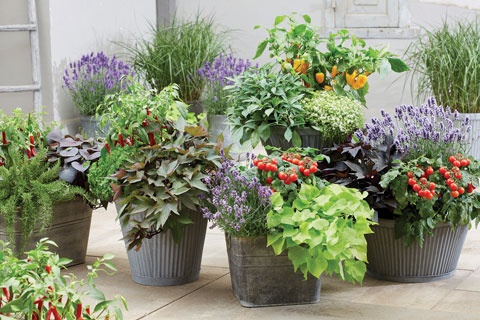5/1/2020
Yo-Ho-Ho: Growing Treasure Island Sweet Potato
Maria Zampini

The Treasure Island Sweet Potatoes are a collaboration between FitzGerald Nurseries and Louisiana State University AgCenter. As an innovator in sweet potatoes in Europe, FitzGerald identified an opportunity to enhance all the healthy and ornamental attributes of ipomoea with the nutritious root of conventional sweet potatoes. Led by Professor Don Labonte, LSU breeders worked to combine the best edible and ornamental attributes, and the Treasure Island Sweet Potatoes were born.
Pictured: Treasure Island Sweet Potatoes come in unique shapes and colors, and can be planted with annual and edible plants.
The Treasure Island series delivers months of color above and below ground. Leaves comes in unique shapes and colors, and the foliage tastes great in salads and smoothies. The edible roots also come in a variety of colors, are highly nutritious and are a great source of dietary fiber.
Production finishing
• Finished sizes: Suggested pot size is a 5-in. round pot planted in May or after first frost. Pot liners direct in paper pots ensuring root spiraling doesn’t cause distortion of roots later. Alternatively, URCs can be stuck direct to pot and pinching should happen twice. The growing environment for the first 14 days should achieve root zone temperatures of 69F (21C) optimum, no lower than 64F (18C) at any time. Normal greenhouse air humidity must be maintained until fully rooted and hardening can take place over a period of three to five days.
• Soil: Well-draining, normal greenhouse soilless media will suffice. For good edible root formation later, soil should be kept moist with air-filled porosity around 30%. For root yield to be successful, it’s imperative that growers don’t cause moisture stress during formative stages of growth between 10 and 30 days, as this is the critical period when the sweet potato root evolves to a storage root.
• Watering: Sweet potatoes can follow the same culture as ornamental varieties of ipomoea with one significant difference—we’re trying to ensure the full root potential of the varieties are encouraged. Attention to watering and phosphorus with managed levels of nitrogen through the first 30 days will influence this long-term capability of the edible roots to develop.
• Fertilizing: Sweet potatoes are forgiving. A triple 13 rate of fertilizer is a good starting point. No need to exceed 100 ppm rates for NPK or half of Hoagland’s solution in a liquid fertilizer regime in the greenhouse.
• Temperatures: Keep greenhouse air temperatures above 69F (21C) and not over 82F (28C). Before shipping, lower temperatures to 64F (18C) to harden the plants to tolerate normal outdoor conditions. Again, keeping within the temperatures of no lower than 64F (18C) is the general rule for outdoor planting.
Growing
• Fertilizing: Sweet potatoes benefit from early applications of nitrogen after planting. Once established, nitrogen should be used sparingly. Too much foliar growth on sweet potato will result in poor storage root development. A triple 13 NPK application at 250 lbs. per acre is fine; garden fertilizer at recommended general rates will suffice. No additional fertilizer is needed after planting.
• Watering: Keep plants on the moderately moist side. Do not overwater sweet potato, as it can lead to root cracking and skin damage on roots. Towards the end of the season, it’s preferable to allow containers to become dry for the two weeks before harvesting your roots.
• Insects: Sweet potato are relatively easy to maintain in the garden and containers. Aphids and whiteflies are the main airborne insects, and in soil, snails, nematodes and weevils like to feed on roots. Most insect pests are superficial.
Miscellaneous production notes
Surprisingly, commercial table stock producers use bare plants with no roots. Sweet potato has a unique ability to root at nodes and these small rootlets become the storage roots. The consumer will buy a plug with pre-formed roots and it’s best to plant these with fresh, stem-bearing nodes underground. These new rootlets will form the best-shaped roots.
Soil is key. A very friable soil in a pot will cause shape variability in the roots, but they’re still delicious! The best-shaped roots will come from plantings in the ground. Potted plants will form the best roots in a heavy garden soil.
Normal practice is to plant sweet potato about 1 ft. apart in a row and in rows 3 ft. apart. Remember to plant deeper so fresh nodes are in the soil to form the best-shaped roots. GT
Maria Zampini is President of UpShoot, LLC.